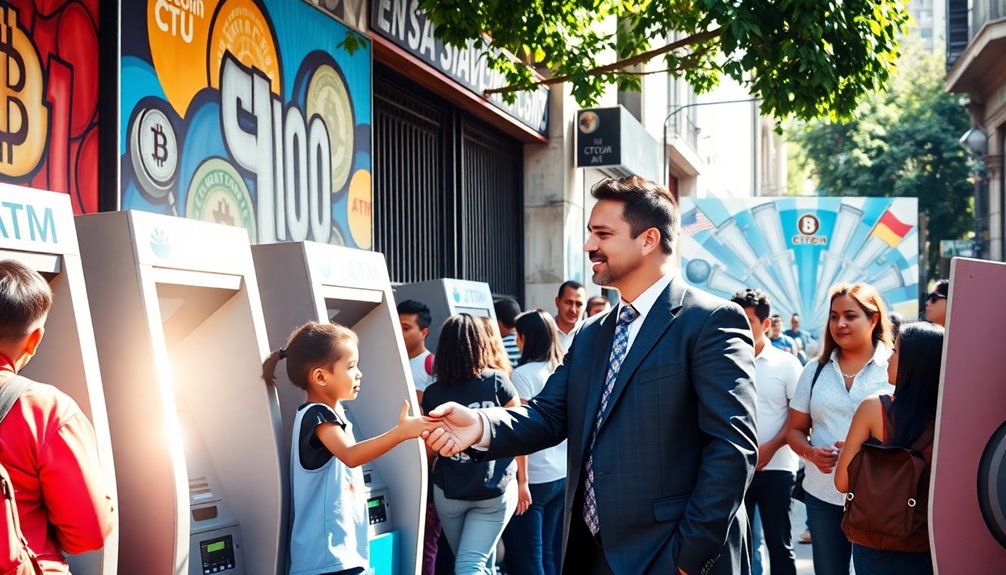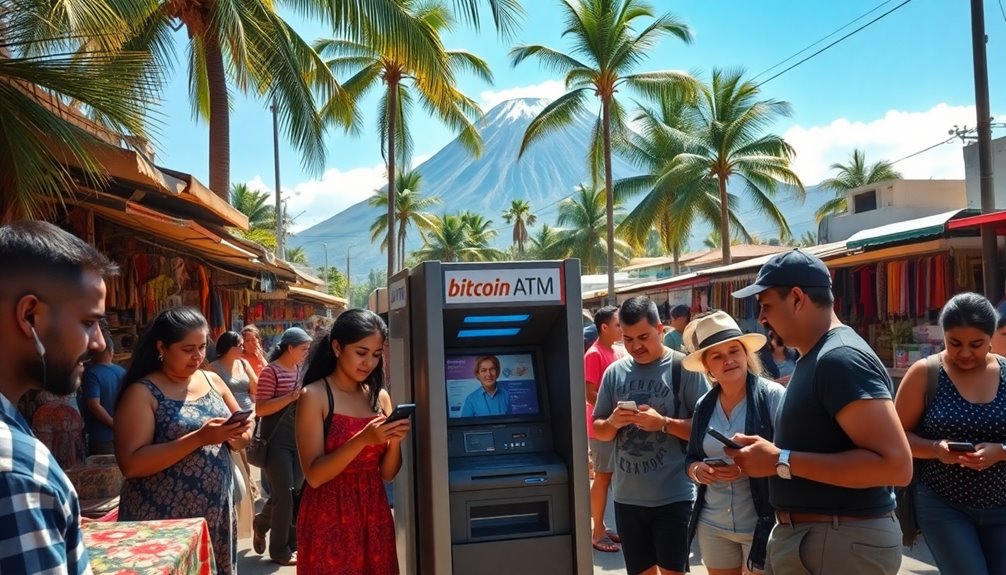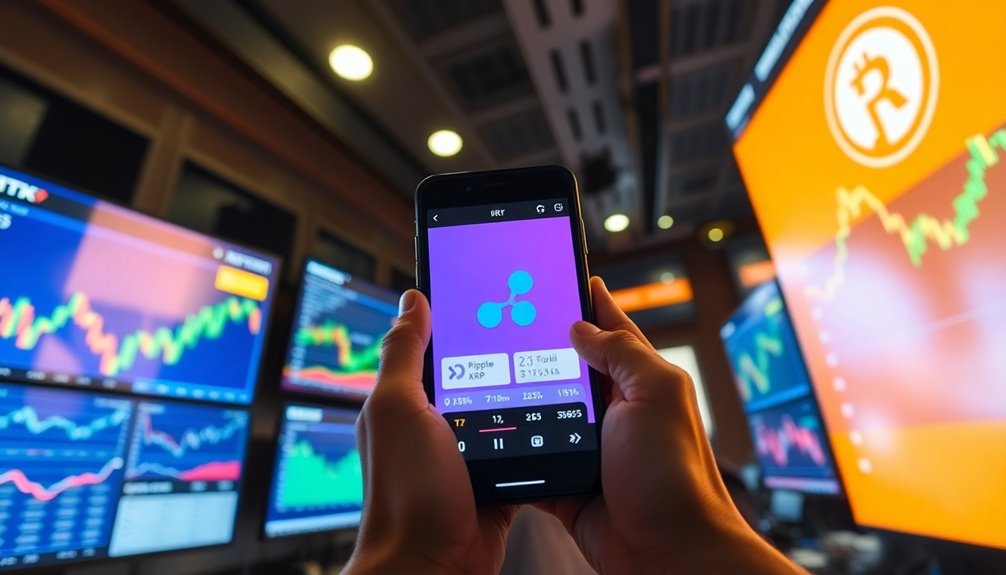El Salvador’s bold move to adopt Bitcoin as legal tender positions it as a potential model for global adoption. By focusing on financial inclusion, it aims to benefit the 70% of citizens without traditional banking access. You’ll see significant economic impacts, like saving $400 million annually in remittance fees and a tourism boost. While public sentiment remains cautious amidst volatility, President Bukele’s initiatives are paving the way for education and regulatory frameworks. This pioneering effort might inspire other nations to explore similar paths, revealing a broader picture of cryptocurrency’s future. Keep exploring to uncover more insights on this fascinating journey. Additionally, El Salvador is also exploring innovative ways to integrate Bitcoin into its economy, such as allowing citizens to sell gold for bitcoin. This demonstrates the government’s commitment to embracing new technologies and providing its people with more options for financial empowerment. As other countries observe the potential benefits and challenges of this approach, they may seek to emulate El Salvador’s pioneering efforts in incorporating cryptocurrency into their own economic systems. This marks an exciting and pivotal moment in the evolution of digital currencies and the global financial landscape.
Key Takeaways
- El Salvador's adoption of Bitcoin as legal tender demonstrates a potential model for increasing financial inclusion among unbanked populations globally.
- The estimated savings of $400 million in remittance fees highlight the economic benefits of Bitcoin integration for countries reliant on remittances.
- Increased tourism and GDP growth following Bitcoin adoption indicate potential positive economic impacts for nations considering similar strategies.
- El Salvador's initiatives emphasize the importance of education and regulatory frameworks to ensure consumer protection and financial stability in cryptocurrency markets.
- The global attention on El Salvador's experiment may influence other nations to explore cryptocurrency solutions for economic revitalization and innovation.
Historical Context of Bitcoin Adoption

When you think about groundbreaking financial moves, El Salvador's decision to adopt Bitcoin as legal tender stands out. On September 7, 2021, El Salvador became the first country to make such a bold move, following a successful experiment that began in the coastal town of El Zonte in 2019. This historic bitcoin adoption aimed to tackle the significant issue of financial inclusion, as nearly 70% of the population lacked access to traditional banking services.
Economic Impact of Bitcoin

Embracing Bitcoin as legal tender has markedly impacted El Salvador's economy, showcasing both potential and challenges. One significant advantage is the projected savings of around $400 million in remittance transfer fees annually, which translates to about 1.5% of the country's GDP. This shift not only eases the burden on families reliant on remittances but also enhances financial inclusion. More Salvadorans now hold Bitcoin wallets than traditional bank accounts, addressing the needs of the 70% of the population that was previously unbanked.
Additionally, following the implementation of the Bitcoin Law, El Salvador saw a 30% increase in tourism, welcoming 2.2 million visitors and helping the country recover its pre-pandemic tourism levels. This influx of tourists has contributed to GDP growth, which surged by 10.3% in 2021, with exports rising by 13%.
As of 2023, El Salvador holds a total of 5,746 bitcoins, reflecting its commitment to integrating cryptocurrency into its national economic strategy. While there are risks involved, the potential for economic transformation through Bitcoin is evident, positioning El Salvador as a case study for global adoption.
President Bukele's Vision

President Nayib Bukele's vision for El Salvador centers on revolutionizing the nation's economy through Bitcoin adoption. By officially designating Bitcoin as legal tender on September 7, 2021, he positioned El Salvador as a pioneer in cryptocurrency utilization. His administration's initiatives, such as offering $30 in Bitcoin to those who registered for the Chivo wallet, aim to encourage widespread participation.
Here's a visual representation of his vision:
| Goals | Strategies | Expected Outcomes |
|---|---|---|
| Financial Inclusion | Incentivize Chivo wallet usage | Access for the unbanked |
| Attract Foreign Investment | Create a crypto-friendly environment | Boost economic growth |
| National Reserves | Strategic Bitcoin purchases | Stabilize the economy |
Bukele's strategic purchases of Bitcoin during market dips have accumulated significant national reserves, totaling 5,748.8 bitcoins. He actively engages citizens through social media, promoting Bitcoin initiatives while addressing criticism regarding volatility. By fostering a culture of Bitcoin adoption, Bukele aims to transform El Salvador into a global hub for cryptocurrency, ultimately benefiting its economy and its people.
Public Sentiment Towards Bitcoin

You might notice that many Salvadorans are hesitant about Bitcoin, often prioritizing cash over cryptocurrency due to economic constraints. There's a clear lack of understanding and trust in Bitcoin among the population, with protests highlighting concerns about its risks. As you explore public sentiment, consider how these factors shape perceptions of this digital currency in El Salvador.
Understanding Bitcoin's Complexity
Often, public sentiment towards Bitcoin in El Salvador reflects a mixture of skepticism and caution. Many Salvadorans who received bitcoin cash quickly converted it to cash, showing a clear desire for stability amid ongoing bitcoin volatility. With over 70% of the population lacking access to traditional financial institutions, the average person remains disengaged from adopting Bitcoin due to limited understanding and resources.
Despite government efforts to promote Bitcoin as legal tender, initial reactions included protests highlighting concerns about consumer protection and the implications of this shift. For most citizens, Bitcoin feels distant, viewed primarily through the lens of household expenses rather than as a viable investment. While a small group of economically resourceful individuals actively dives into Bitcoin, the broader populace grapples with the complexities of this cryptocurrency.
The combination of ongoing volatility and the lack of tangible benefits for everyday life contributes considerably to the cautious public sentiment. As you consider El Salvador's approach to Bitcoin, it's crucial to recognize how these factors shape perceptions and determine the potential for wider acceptance and adoption in the future.
Economic Constraints and Cash
Economic constraints heavily influence public sentiment towards Bitcoin in El Salvador. Many Salvadorans face pressing financial realities that prioritize household expenses over speculative investments like cryptocurrency. As a result, when they receive Bitcoin through the government's digital wallet initiative, they often convert it to cash immediately, reflecting a cautious and skeptical public perception of digital currencies.
You might notice that reports indicate more Salvadorans hold cash than actively engage with Bitcoin. This trend stems from a general lack of understanding and comfort with cryptocurrencies. While a small group of economically resourceful individuals might invest in Bitcoin, the broader population remains disengaged, primarily due to financial instability and risk aversion.
The persistent volatility of Bitcoin further complicates matters. For most citizens, it appears more as a risky gamble than a viable financial tool. This skepticism hinders cryptocurrency adoption, as many view it through the lens of their economic constraints. Ultimately, until public perception shifts and financial stability improves, Bitcoin will struggle to gain widespread acceptance in El Salvador's economy.
Public Perception and Trust
How can a population embrace a financial technology like Bitcoin when skepticism looms large? In El Salvador, public perception of Bitcoin is clouded by distrust and economic constraints. Despite the government's push for adoption, many Salvadorans remain cautious, preferring to convert Bitcoin cash into immediate cash instead of holding onto the volatile asset. This behavior reveals a fundamental mistrust in the cryptocurrency's ability to provide financial stability.
Local testimonies indicate a general lack of understanding about Bitcoin, contributing to a disengagement from this digital asset. Many people prioritize household expenses over investments in cryptocurrency, further fueling skepticism. Protests erupted shortly after Bitcoin's adoption as legal tender, showcasing significant public opposition rooted in fears of economic inequality and the potential for financial instability.
In a landscape where immediate liquidity is essential, the average Salvadoran's focus is on cash availability rather than the long-term benefits of cryptocurrency. Until trust can be built and a clearer understanding of Bitcoin's role in their lives is established, skepticism will likely continue to dominate the conversation around this innovative financial technology.
International Financial Oversight

As El Salvador boldly integrates bitcoin into its economy, the need for international financial oversight becomes increasingly evident. The International Monetary Fund (IMF) has recognized the country's bitcoin holdings, underscoring the importance of transparency in this ambitious project. With the potential risks to financial stability, the IMF has raised concerns about the fiscal implications of bitcoin adoption and the need for stringent consumer protection measures.
Ongoing discussions between the IMF and El Salvador's government aim to tackle these risks head-on, ensuring that safeguards are in place to mitigate any negative impacts. The IMF has warned that embracing bitcoin as legal tender could pose significant challenges to the nation's overall financial health. As El Salvador forges ahead, its approach not only affects its economy but also sets a precedent for other countries contemplating similar cryptocurrency integration strategies.
International financial oversight will be critical in shaping the outcomes of El Salvador's bitcoin venture. By prioritizing transparency and collaboration with global financial institutions, El Salvador can work towards achieving financial stability while maneuvering through the complexities of bitcoin adoption. This careful balance will be essential for the nation and any others inspired by its bold experiment.
Education and Workforce Initiatives

What if a well-informed workforce could be the key to successfully steering El Salvador's ambitious bitcoin initiative? The National Bitcoin Office (ONBTC) has recognized this potential by launching a Bitcoin certification program aimed at educating 80,000 government employees on bitcoin and blockchain technology. This initiative directly integrates cryptocurrency knowledge into public service, ensuring that civil servants understand the nuances of digital currencies.
Through specialized training, public officials will be empowered to effectively manage and implement bitcoin-related policies. This strategic educational push aligns with the government's broader vision of promoting financial inclusion and stimulating economic growth through innovative digital solutions.
Here's what you can expect from this initiative:
- Informed Governance: Civil servants equipped with knowledge can make better decisions.
- Broader Financial Literacy: A ripple effect that extends beyond public service into various sectors.
- Enhanced Public Service: Citizens benefit from knowledgeable officials who understand cryptocurrency.
- Economic Growth: A skilled workforce can drive El Salvador's leadership in the cryptocurrency space.
Global Influence and Partnerships

El Salvador's bold move to adopt Bitcoin as legal tender has sparked a wave of interest and influence across the globe. This pioneering step has encouraged countries like Argentina to explore cryptocurrency as a means to stabilize their economies. El Salvador's practical case study highlights both the benefits and risks of Bitcoin integration, making it a focal point for global crypto discussions.
To enhance its digital infrastructure and promote Bitcoin-related investments, El Salvador has formed key partnerships with private sector entities and tech companies. These collaborations aim to position El Salvador as a leader in the global crypto space, attracting foreign investment and tourism through its innovative policies.
Here's a snapshot of El Salvador's global partnerships and influences:
| Partnerships | Impact |
|---|---|
| Private Sector Collaborations | Boosts digital infrastructure and innovation |
| Tech Company Engagements | Advances Bitcoin adoption and user education |
| International Relations | Increases foreign investment in crypto |
| Regional Influence | Inspires neighboring countries to explore Bitcoin |
As El Salvador navigates this uncharted territory, its ability to balance innovation with financial stability will be significant for its ongoing success and influence in the global crypto arena.
Regulatory Challenges Ahead

Maneuvering the complex landscape of cryptocurrency regulation, El Salvador faces significant challenges in ensuring that its Bitcoin initiatives align with international standards. The government is diligently enhancing regulatory frameworks to address concerns raised by the International Monetary Fund (IMF) about financial stability and consumer protection. As Bitcoin adoption gains momentum, these frameworks must adapt to mitigate potential fiscal risks.
Key challenges include:
- Establishing transparent regulatory frameworks to attract global investors.
- Ensuring financial stability while promoting Bitcoin-backed Volcano Bonds.
- Educating government employees through the National Bitcoin Office (ONBTC) on blockchain technology.
- Balancing innovation with the scrutiny of international financial bodies.
Ongoing discussions between the IMF and El Salvador's government highlight the need for effective financial oversight and consumer protection measures. As the country refines its regulatory approach, it must navigate these challenges carefully to pave the way for sustainable Bitcoin adoption. The road ahead is complex, but with the right strategies, El Salvador could set a precedent for other nations exploring cryptocurrency integration.
Future Prospects for El Salvador

As you consider El Salvador's future, the potential for economic growth through Bitcoin adoption stands out. The government's commitment to refining regulatory frameworks will play an essential role in shaping this landscape. With increasing foreign investment and tourism, the country is poised for significant transformation. Additionally, the implementation of Bitcoin IRAs could provide citizens with tax advantages while encouraging long-term investment in cryptocurrency.
Economic Growth Potential
The economic growth potential for El Salvador appears promising, driven largely by its bold embrace of Bitcoin. Since the country's adoption of Bitcoin as legal tender, it has seen significant economic shifts. In 2021, El Salvador's GDP grew by 10.3%, fueled by increased foreign investment in the crypto sector. Furthermore, tourism has surged by 30%, with 2.2 million visitors flocking to the country, returning to pre-pandemic levels.
Key factors contributing to this growth include:
- Bitcoin-backed Volcano Bonds: Aiming to attract USD $1.6 billion for Bitcoin City development.
- Daily Bitcoin Purchases: Commitment to buying one Bitcoin daily, totaling 5,746 by 2023.
- Enhanced Tourism: A significant rise in visitors since the Bitcoin Law implementation.
- Foreign Investment Opportunities: Increased interest from global investors in the crypto market.
With these developments, El Salvador's economic growth potential looks bright. As the nation continues to adapt and innovate, it sets the stage for a more inclusive financial landscape, attracting further foreign investment and solidifying its place in the global cryptocurrency arena.
Regulatory Framework Development
El Salvador's journey into the world of Bitcoin isn't just about economic growth; it also involves developing a robust regulatory framework to support this digital currency landscape. By 2024, you can expect the government to refine its regulations, focusing on sustainability and adapting to global cryptocurrency trends. Engaging with international financial organizations, they're addressing concerns about fiscal stability and transparency in their Bitcoin initiatives.
The National Bitcoin Office (ONBTC) is actively educating citizens and government employees on cryptocurrency, creating a knowledgeable workforce essential for effective regulatory development. This initiative is vital as the country explores innovative financial instruments like Bitcoin-backed Volcano Bonds, designed to attract global investors while ensuring regulatory oversight of crypto projects.
As El Salvador navigates its role in the evolving cryptocurrency landscape, ongoing discussions will highlight the importance of balancing economic growth with consumer protection and financial stability. You'll see that the success of this regulatory framework will not only influence El Salvador's Bitcoin endeavors but could also serve as a model for other nations looking to embrace digital currencies responsibly.
Frequently Asked Questions
Why Does El Salvador Use Bitcoin?
El Salvador uses Bitcoin to enhance financial inclusion for its citizens, especially those lacking access to traditional banking. By adopting Bitcoin, you're helping reduce remittance costs, saving significant money for families. The government launched the Chivo digital wallet, offering incentives for users, which encourages widespread participation. This move positions the country as a cryptocurrency hub, attracting foreign investment and supporting economic growth. It's about leveraging technology to improve financial access and opportunities for everyone.
How Much Does El Salvador Have in Bitcoin?
Isn't it ironic that a small country like El Salvador holds a staggering 5,748.8 bitcoins? You'd think they'd be cautious, especially with the cryptocurrency's wild price swings. Yet, they're committed to buying one bitcoin daily, investing over $600 million so far. Despite the market's ups and downs, with prices plummeting to around $20,000, the government's holding firm, aiming for long-term gains rather than quick profits.
Who Brought Bitcoin to El Salvador?
You can trace Bitcoin's introduction to El Salvador back to President Nayib Bukele. He announced the adoption of Bitcoin as legal tender on September 7, 2021. Prior to that, the local community in El Zonte had already started experimenting with Bitcoin transactions in 2019. Bukele's administration then incentivized its use by offering $30 in Bitcoin to citizens who registered for the Chivo digital wallet, aiming to enhance financial inclusion.
Conclusion
So, El Salvador's bold bet on Bitcoin turns out to be a double-edged sword. While you might think that embracing cryptocurrency could elevate the nation to new economic heights, it's rather ironic that the very gamble aimed at future prosperity has sparked skepticism and concern both domestically and internationally. If Bukele's vision for a Bitcoin utopia falters, it raises the question: could this experiment in financial innovation become a cautionary tale instead? Only time will tell.









